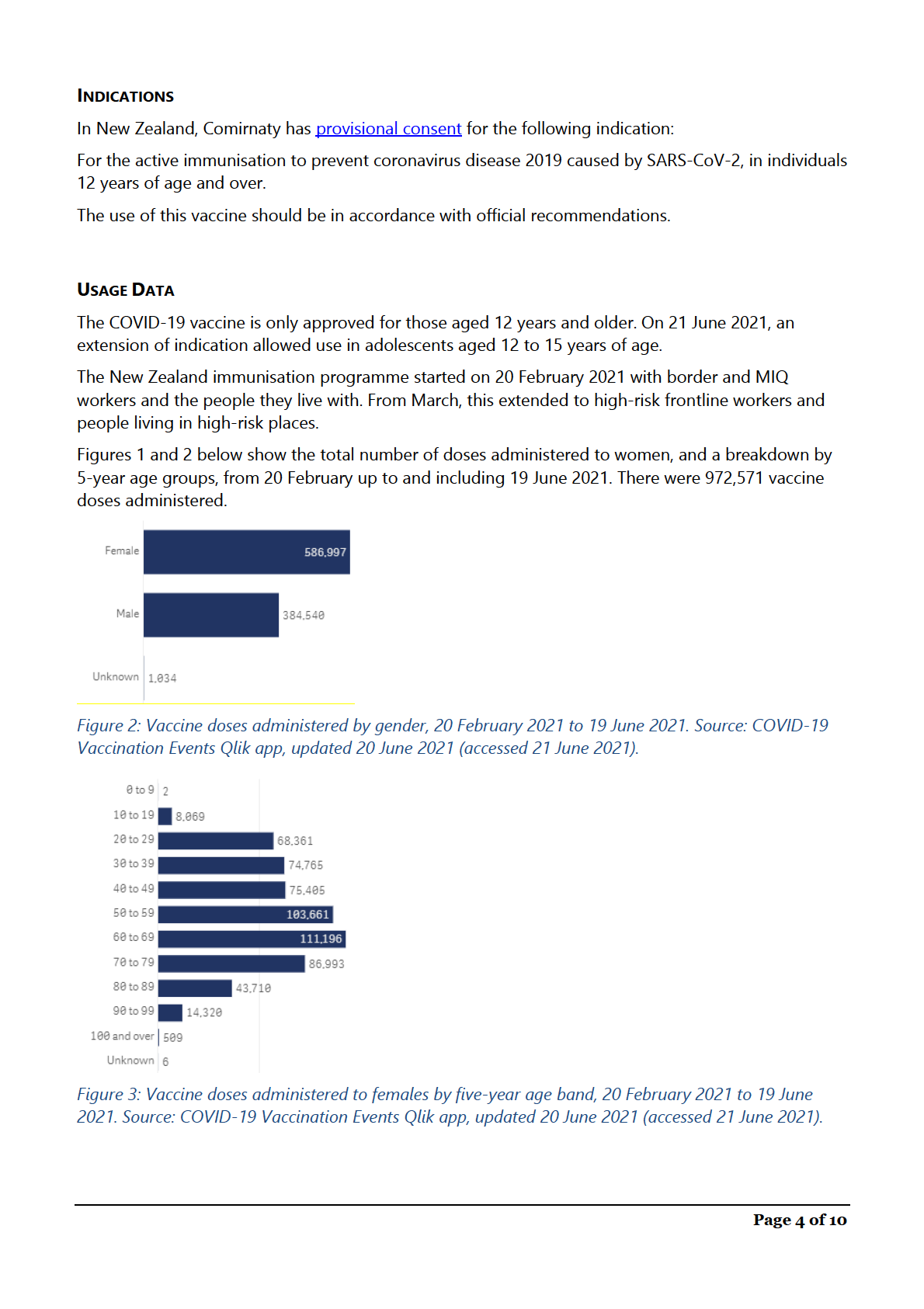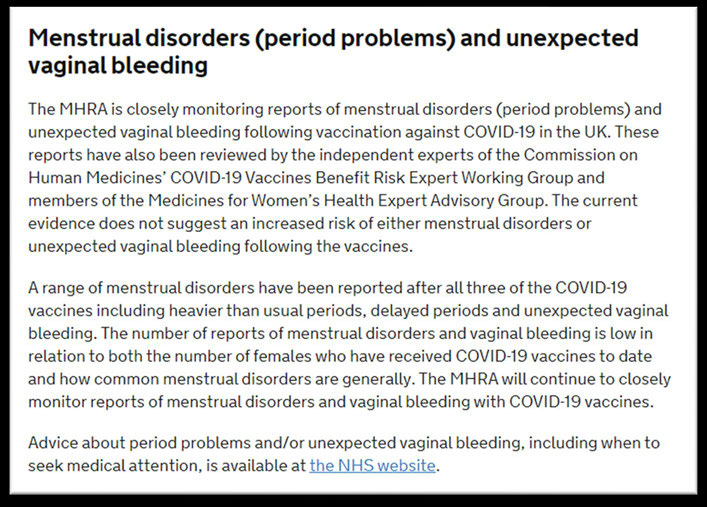 Memo
Date:
Memo
Date:
22 June 2021
To:
s 9(2)(g)(ii)
Manager, Clinical Risk Management, Medsafe
From:
s 9(2)(g)(ii)
Subject:
Comirnaty vaccine and menstrual disorders/unexpected vaginal bleeding
Incident ID:
27822
Lotus Notes Location: Immunological Products &
Vaccines – COVID-19
For your:
Action: [√] Decision: [√] Information: [√]
DESCRIPTION
There have been reports of menstrual disorders, and other related disorders such as unexpected
vaginal bleeding, as an adverse effect fol owing Comirnaty administration in New Zealand.
This memo reviews the information currently available on this issue and considers whether any further
action is required.
NATURE OF THE SAFETY CONCERN
Abnormal vaginal bleeding [1]
Per vaginum (PV) bleeding often originates from the uterus, but bleeding from the vulva, vagina or
cervix can also occur.
Heavy, irregular or missed periods can be normal for some people, or can be related to lifestyle
factors such as stress, weight loss, excessive exercise, being overweight and contraceptive use [2].
Abnormal bleeding frequency is considered to be a cycle shorter than 24 days or longer than 38 days.
Prolonged duration is longer than eight days. Irregular menstruation is a cycle length that varies by
more than 8-10 days. Flow volume is subjective.
Possible medical causes of uterine bleeding include anovulatory cycles, pregnancy, menopause,
structural abnormalities, bleeding disorders and malignancy. Possible causes of lower genital tract
bleeding include infection, trauma, urogenital atrophy or malignancy.
Diagnosis and management [1]
Differential diagnosis is guided by bleeding type:
• heavy menstrual bleeding
• intermenstrual or unscheduled/breakthrough bleeding
• post-coital bleeding (not discussed here)
• post-menopausal bleeding
Page 1 of 10
• absence of bleeding.
The type of bleeding can help to identify the most likely causes. The first step is usual y to exclude
pregnancy, unless the patient is post-menopausal.
History-taking should include age, menstrual bleeding patterns, characteristics and timing of bleeding,
associated symptoms, medicines use, sexual health history, obstetric history, surgical history, and
symptoms arising from systemic disease.
Medicines that may be associated with PV bleeding include hormonal contraception, menopausal
hormone therapy, anticoagulants, tamoxifen, antipsychotics and some herbal products.
Heavy menstrual bleeding
Heavy menstrual bleeding is usual y defined as a bleeding volume that interferes with quality of life, as
measurement of actual bleeding volume is usually impractical.
Heavy menstrual bleeding can be related to uterine structure and this becomes more common with
increasing age. For example, fibroids, polyps, adenomyosis, and endometrial cancer or hyperplasia.
Non-structural causes of heavy menstrual bleeding include:
• medicines (eg, copper IUD, tamoxifen, depot medroxyprogesterone acetate, menopausal
hormone therapy, anticoagulants, aspirin, some herbal supplements)
• ovulatory dysfunction (eg, psychological stress, weight change, excessive exercise, polycystic
ovary syndrome, thyroid disease)
• coagulation disorders
• endometrial disorders.
Investigations can include pregnancy tests, complete blood counts, thyroid-stimulating hormone,
coagulation and liver function tests, Pipelle biopsy and pelvic ultrasound.
Treatment is influenced by the cause of bleeding, need for contraception, any contraindications to
oestrogen or progestogen use, and patient preference. Treatments include:
• hormonal treatments (Mirena IUD, combined oral contraception, progestogen-only
contraceptives, cyclical progestogens)
• non-hormonal treatments (tranexamic acid, mefenamic acid)
• surgery can be considered if pharmacological treatments are ineffective.
Intermenstrual or unscheduled bleeding
Intermenstrual bleeding is any cyclic or random bleeding between menstrual periods. Unscheduled or
breakthrough bleeding occurs between withdrawal bleeds on women hormonal contraception or
menopausal hormone therapy.
Common causes include ovulation, sexual y transmitted infections (STI), polyps, progestogen-only
contraceptives, endometrial malignancy or hyperplasia and Caesarean scar defect.
Investigations include pregnancy testing, STI testing, cervical smear testing and pelvic ultrasound, with
further investigation and appropriate treatment if results are abnormal. Some women may experience
light spotting or bleeding while ovulating. If investigations are normal, no further intervention may be
required.
Post-menopausal bleeding
Post-menopausal bleeding is defined as occurring more than 12 months of menopausal amenorrhoea.
Page 2 of 10





s 9(2)(ba)(i)
MHRA weekly summary of Yellow Card reporting
The MHRA has issued a brief statement on menstrual disorders and unexpected vaginal bleeding, as
part of the Coronavirus vaccine - weekly summary of Yellow Card reporting (Figure 4).
The MHRA did not consider that there appeared to be an increased risk after vaccination, and that
numbers of reports were low considering the number of females who have received the vaccine and
how common menstrual disorders are general y [3].
Figure 4: MHRA statement on menstrual disorders and unexpected vaginal bleeding [3]
No other regulators appear to have issued statements on this issue.
Discussion in the literature
Letter to the editor: ‘CoViD-19 post-vaccine menorrhagia, metrorrhagia or postmenopausal bleeding and
potential risk of vaccine-induced thrombocytopenia in women’
Page 7 of 10
This letter was submitted by the Subject Leader in Pharmacy at the University of Huddersfield, United
Kingdom in response to an opinion piece titled ‘Thrombosis after covid-19 vaccination: these rare
events must not derail vaccination efforts’ [4].
The letter stated that there have been many reports of post-vaccination menstrual irregularities
submitted in the UK, with twice as many reports submitted for the Vaxzevria than Comirnaty. The
writer notes that the number or reports is likely to be an underestimate as many events may not be
reported.
The writer states that there have been reports of haemorrhage, blood clots and thrombocytopaenia
following COVID-19 vaccination. The European Summary of Product Characteristics (SmPC) for
Vaxzevria has been updated to include thrombocytopaenia as an adverse reaction, with the frequency
‘common’.
The writer believes that vaccine-induced thrombocytopenia may be an explanation for reports of
heavy menstrual bleeding.
Comment: In the UK, more doses of Vaxzevria have been administered (approximately 42.3 million
doses) than Comirnaty (approximately 26.4 million doses) [3]. This may explain the difference in the
numbers of reports.
No studies or case reports that describe menstrual changes or unexpected vaginal bleeding after
COVID-19 vaccination were identified in the literature.
VigiLyze data
s 9(2)(ba)(i)
Page 8 of 10
s 9(2)(ba)(i)
PUBLIC INTEREST
There is significant public and media interest in this topic, with accounts of menstrual irregularities
published on social media platforms.
For example, the Guardian published an article about anecdotal accounts of disrupted menstrual
cycles. Dr Kate Clancy, an associate professor at the University of Il inois, and Dr Katharine Lee, a
postdoctoral researcher at Washington University School of Medicine, have started a survey to explore
these accounts [5].
The article emphasised that menstrual changes are reported to be short-lived and do not appear to
affect large numbers of people. Many people experience variations between menstrual cycles and
patterns can be affected by other factors such as stress.
Public interest may stimulate reporting of menstrual disturbances and unexpected vaginal bleeding.
Some of the New Zealand case reports referred to hearing about the experiences of other women.
CONCLUSIONS AND PROPOSED ACTIONS
Currently, there is insufficient information to confirm a signal of menstrual disturbances or unexpected
vaginal bleeding with Comirnaty.
As of 22 June 2021, CARM had received 22 reports of menstrual disturbances or unexpected vaginal
bleeding with Comirnaty. These included heavy, light, delayed and early menstrual periods.
Unexpected vaginal bleeding was reported in women who usual y don’t bleed due to their
contraceptive method, and in postmenopausal women.
In one case, unexplained PV bleeding was reported in a woman with a history of hysterectomy. The
results of examination and investigations (swabs, vault smears, bloods and pelvic ultrasound) were
normal. Two cases of heavy menstrual bleeding were associated with bleeding at other sites (nose and
gums).
Page 9 of 10
Heavy, irregular or missed periods can be normal for some people, or they can be related to lifestyle
factors such as stress, weight loss, excessive exercise, obesity and contraceptive use.
A number of underlying medical conditions can be associated with abnormal uterine bleeding,
including pregnancy, menopause, structural abnormalities, bleeding disorders and malignancy.
Possible causes of lower genital tract bleeding include infection, trauma, urogenital atrophy or
malignancy.
Given that several thousand women are hospitalised each year due to menstrual disorders or other
abnormal PV bleeding, the volume of reports received to date is not unexpected.
At this time, the reports do not indicate that changes to menstrual periods persisted beyond one or
two cycles or that unexpected vaginal bleeding was recurrent.
Medsafe wil monitor this issue through routine pharmacovigilance activities. This includes monitoring
New Zealand case reports, company safety reports, action from other regulators and information in
the literature.
The Immunisation Safety Monitoring Board (ISMB) should be made aware of this issue and the public
interest surrounding it.
RECOMMENDATIONS
It is recommended that:
1.
This topic is presented to the COVID-19 Vaccine ISMB.
Yes
2.
This topic is monitored through routine pharmacovigilance.
Yes
REFERENCES
1.
bpacnz. 2019.
Investigating and managing abnormal vaginal bleeding: an overview December
2019. URL: https://bpac.org.nz/2019/bleeding.aspx (accessed 21 June 2021).
2.
National Health Service. 2019.
Stopped or missed periods 2 August 2019. URL:
https://www.nhs.uk/conditions/stopped-or-missed-periods/ (accessed 22 June 2021).
3.
Medicines & Healthcare products Regulatory Agency. 2021.
Coronavirus vaccine - weekly
summary of Yellow Card reporting 10 June 2021. URL:
https://www.gov.uk/government/publications/coronavirus-covid-19-vaccine-adverse-
reactions/coronavirus-vaccine-summary-of-yellow-card-reporting (accessed 16 June 2021).
4.
H Merchant. 2021. Rapid Response: CoViD-19 post-vaccine menorrhagia, metrorrhagia or
postmenopausal bleeding and potential risk of vaccine-induced thrombocytopenia in women
[Letter to the editor].
BMJ 373(n958): DOI: 10.1136/bmj.n958
5.
N Davis. 2021.
Any menstrual changes after Covid jab would be short-lived, experts say 4 June
2021. URL: https://www.theguardian.com/society/2021/jun/04/any-menstrual-changes-covid-
jab-would-be-short-lived-experts (accessed 16 June 2021).
Page 10 of 10





